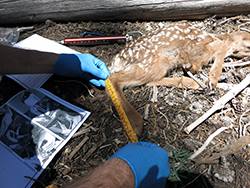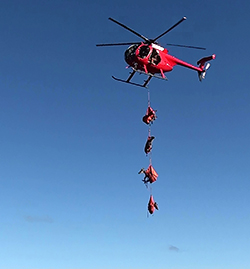
CDFW Environmental Scientist Brian Ehler measures the hind-foot length on a fawn captured near Medicine Lake for a mule deer study.

CDFW Environmental Scientist Brian Ehler measures the hind-foot length on a fawn captured near Medicine Lake for a mule deer study.
Driving up Interstate 5 through Siskiyou County in northern California, one cannot help but take notice of the looming, majestic land mass of Mount Shasta, the largest volcano in the Cascade system.
In this rugged region of the Golden State, mule deer are an iconic species, valued by recreationists and required by wild carnivores who prey upon them for nourishment. Mule deer are considered a “foundation species” because the large landscapes that are necessary for their survival can also be home to a vast array of other wildlife and plant species. But mule deer populations have dramatically declined in recent decades across many western ranges, and in Siskiyou County, this decrease has prompted researchers from CDFW and the University of California, Santa Cruz to partner on a multi-year effort to investigate the population dynamics of this high-profile species.
Since 2015, 51 adult female mule deer and 37 fawns have been captured in the Mount Shasta region. Biological samples, including blood and parasites, have been collected, physical measurements of body condition and age recorded and telemetry collars attached to each subject. Collars on adult deer provide a GPS location every hour and alert researchers when a mortality occurs. The collars also document movement details, including migration routes and the location of critical winter and reproductive ranges. The fawn collars feature location beacons that allow researchers to monitor both general movements and when a mortality has occurred. Once a mortality alert is sent from a collar, a search of the site and an examination of the carcass ensues to determine if the deer died from predation or other causes, such as disease or malnutrition. The collars have timed releases and are set to drop off the animal after 18 months. Researchers can then reuse the collars after retrieving them by following a GPS signal. This high-tech, high-resolution documentation of deer behavior is vital for prioritizing the conservation value of landscapes so they may be better protected in the future.
With the recent arrival of gray wolves to northeastern California, predators are a key focus of the mule deer project. Understanding the influence this large canid will have on natural prey species begins with establishing baselines of how current predators -- including mountain lions, bears, bobcats and coyotes -- are affecting prey in this region. Mountain lions, which rely on deer as the primary component of their diet, are a major focus of this study. Researchers have captured and affixed five adult mountain lions with GPS telemetry collars, allowing them to track and study rates of predation, feeding patterns and diet composition.
The analysis of fecal DNA combined with new statistical techniques is another way to study population density and composition across broad landscapes. DNA analysis allows researchers to determine the sex and identity of an individual deer, which is used to estimate densities and gender ratios. Researchers are collecting fecal samples throughout the mule deer’s summer range, in the hopes of reliably extrapolating estimates of density and sex ratios across the entire region.
This project, which began in 2015, is scheduled to continue into 2019, as researchers strive to gain further insight into the lives of mule deer and predators across this ecologically complex and breathtakingly beautiful region of the state.
California Department of Fish and Wildlife photos.
Top photo: Mount Shasta in winter.